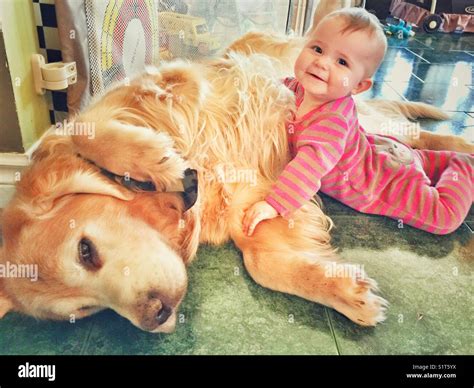
A golden retriever in a Pennsylvania neighborhood has become a local celebrity for initiating playtime with his favorite ball, fostering a sense of community and joy among residents. Teddy, known for his friendly demeanor, has turned regular walks into opportunities for impromptu games of fetch, bringing neighbors together and brightening their days.
Teddy, a four-year-old golden retriever from suburban Pennsylvania, has become an unexpected social catalyst, transforming mundane neighborhood strolls into lively gatherings centered around a simple game of fetch. His endearing habit of carrying his favorite tennis ball and initiating playtime with anyone he encounters has not only earned him the title of “Neighborhood Pup” but has also fostered a stronger sense of community among residents.
According to his owner, Kelly Roberts, Teddy’s passion for playtime is innate. “He’s always loved playing fetch,” Roberts explained. “It’s his absolute favorite thing to do. He just naturally started offering his ball to people on our walks, and it’s grown from there.” What began as a simple act of canine enthusiasm has blossomed into a heartwarming ritual, transforming strangers into acquaintances and forging bonds through shared moments of lighthearted fun.
The impact of Teddy’s playful antics extends far beyond mere entertainment. In an era marked by increasing social isolation and digital distractions, his spontaneous games of fetch provide a tangible reminder of the power of human connection. Residents who were once strangers now greet each other by name, sharing stories and laughter as they participate in Teddy’s impromptu playtime sessions.
“It’s amazing how much joy he brings to everyone,” said resident Sarah Miller, a frequent participant in Teddy’s fetch games. “He has this way of instantly brightening your day. It’s more than just playing with a dog; it’s about connecting with people and feeling like you’re part of something special.”
Teddy’s influence is particularly notable among older residents, many of whom have expressed gratitude for the opportunity to engage in physical activity and social interaction. For some, Teddy’s visits are the highlight of their day, offering a welcome respite from the loneliness and isolation that can often accompany old age.
“He’s like a little ray of sunshine,” said 80-year-old neighbor, Robert Johnson. “I don’t get out much anymore, but I always look forward to seeing Teddy. He reminds me of the simple joys in life, and he makes me feel like I’m still part of the community.”
The story of Teddy and his neighborhood playtime sessions has resonated far beyond the confines of their Pennsylvania community. News outlets and social media platforms have shared his heartwarming tale, inspiring others to seek out opportunities for connection and community building in their own neighborhoods.
“We never imagined that Teddy’s little games of fetch would have such a big impact,” Roberts said. “It just goes to show that even the simplest acts of kindness and connection can make a world of difference.”
Teddy’s story serves as a poignant reminder of the importance of fostering community bonds, especially in an increasingly fragmented society. His playful spirit and infectious enthusiasm offer a valuable lesson in the power of simple interactions to bridge divides, create connections, and bring joy to the lives of others. In a world often characterized by cynicism and division, Teddy stands as a beacon of hope, reminding us that even a simple game of fetch can have a profound impact on the human heart.
Expanded Context and Analysis
The narrative of Teddy, the ball-loving golden retriever, transcends the simple charm of a feel-good story. It delves into the core aspects of community building, social interaction, and the often-underestimated role animals play in fostering human connections. In an age dominated by digital interactions and often characterized by social isolation, Teddy’s initiative in instigating playtime serves as a refreshing reminder of the fundamental human need for connection and belonging.
The Power of Play in Community Building:
Play, in its various forms, has long been recognized as a vital component of human development and social cohesion. From childhood games to adult recreational activities, play provides opportunities for individuals to interact, cooperate, and build relationships. Teddy’s fetch games exemplify this principle in action. By offering his ball and inviting participation, Teddy creates a shared experience that transcends age, background, and social status. These impromptu playtime sessions become mini-social gatherings, fostering a sense of camaraderie and shared identity among neighbors.
The act of playing together breaks down barriers and facilitates communication. As individuals focus on the shared goal of the game, they are more likely to relax, open up, and engage with one another in a positive and constructive manner. This, in turn, builds trust and strengthens relationships, transforming a collection of individuals into a cohesive community.
Combating Social Isolation:
Social isolation is a growing concern in modern society, particularly among older adults and individuals living alone. Studies have shown that social isolation can have detrimental effects on both physical and mental health, increasing the risk of depression, anxiety, and even cardiovascular disease. Teddy’s presence in the neighborhood provides a valuable antidote to social isolation, particularly for those who may lack regular opportunities for social interaction.
His visits offer a chance for residents to connect with others, engage in physical activity, and experience a sense of belonging. For some, Teddy’s games of fetch may be the only social interaction they have all day, providing a much-needed boost to their mood and overall well-being. The simple act of throwing a ball and sharing a laugh with a neighbor can make a significant difference in the lives of those who are feeling lonely or isolated.
The Role of Animals in Fostering Human Connection:
Animals, particularly dogs, have a unique ability to connect with humans on an emotional level. Their unconditional love, loyalty, and playful nature make them ideal companions and social facilitators. Teddy embodies these qualities, using his playful antics to bridge social divides and bring people together.
Dogs have been shown to reduce stress, lower blood pressure, and increase levels of endorphins, the body’s natural mood boosters. Their presence can create a sense of calm and well-being, making it easier for people to relax and connect with one another. Teddy’s friendly demeanor and enthusiasm for playtime serve as an invitation for residents to interact, fostering a sense of warmth and connection that extends beyond the immediate game of fetch.
Lessons for Other Communities:
Teddy’s story offers valuable lessons for other communities seeking to foster stronger social bonds and combat social isolation. While not every neighborhood has a dog like Teddy, there are numerous ways to create opportunities for connection and community building.
- Organize community events: Block parties, picnics, and neighborhood clean-ups can provide opportunities for residents to meet and interact in a relaxed and informal setting.
- Create shared spaces: Parks, community gardens, and common areas can serve as gathering places for residents to socialize and engage in activities together.
- Encourage neighborly interaction: Simple acts of kindness, such as offering to help a neighbor with groceries or yard work, can go a long way in building relationships and fostering a sense of community.
- Support local initiatives: Volunteering for local organizations or participating in community projects can provide opportunities to connect with others and make a positive impact on the neighborhood.
- Promote pet ownership: Encouraging responsible pet ownership can bring numerous benefits to a community, including increased social interaction, improved physical health, and a stronger sense of community spirit.
By embracing these strategies, communities can create environments that foster connection, combat social isolation, and promote the well-being of all residents.
Ethical Considerations and Responsible Pet Ownership:
While Teddy’s story is undoubtedly heartwarming, it also raises important ethical considerations regarding responsible pet ownership. It is crucial to ensure that all interactions between pets and community members are safe, consensual, and respectful.
- Dog temperament and training: Owners should ensure that their dogs are well-socialized, properly trained, and possess a temperament suitable for interacting with strangers, including children and individuals who may be apprehensive around dogs.
- Leash laws and public spaces: Owners should adhere to all leash laws and regulations regarding pets in public spaces, ensuring that their dogs are always under control and do not pose a threat to others.
- Consent and boundaries: It is essential to respect the boundaries of individuals who may not wish to interact with dogs. Owners should always ask for permission before allowing their dogs to approach or engage with others.
- Hygiene and cleanliness: Owners should be responsible for cleaning up after their dogs and ensuring that they do not create a mess or nuisance in public spaces.
- Allergies and phobias: Owners should be mindful of individuals who may have allergies or phobias related to dogs and take appropriate precautions to avoid causing discomfort or distress.
By adhering to these ethical considerations and practicing responsible pet ownership, owners can ensure that their dogs continue to be a positive force in their communities, fostering connection and bringing joy to the lives of others.
The Long-Term Impact:
The long-term impact of Teddy’s initiative could potentially lead to a more tightly-knit, supportive, and resilient community. Increased social interaction can lead to a greater sense of collective efficacy, where residents feel empowered to address local challenges and work together to improve their neighborhood. Stronger community bonds can also translate into reduced crime rates, improved mental and physical health outcomes, and a greater sense of overall well-being.
Furthermore, Teddy’s story could inspire other individuals and communities to adopt similar initiatives, creating a ripple effect of positive change. By highlighting the power of simple acts of kindness and connection, Teddy’s tale can serve as a catalyst for a broader movement towards greater social cohesion and community engagement.
Beyond the Local Impact: A National Perspective:
The relevance of Teddy’s story extends far beyond his local Pennsylvania neighborhood. In an era of increasing political polarization and social fragmentation, the need for community building and social connection is more pressing than ever. Teddy’s initiative provides a tangible example of how simple acts of kindness can bridge divides, foster understanding, and create a sense of shared identity.
His story resonates with a broader national desire for unity, compassion, and a return to traditional values of neighborliness and community spirit. In a world often characterized by cynicism and division, Teddy offers a beacon of hope, reminding us that even small acts of connection can have a profound impact on the human heart.
Conclusion:
Teddy, the golden retriever with a passion for playtime, has inadvertently become a symbol of community building and social connection. His simple act of offering his ball to strangers has transformed his neighborhood, fostering a sense of camaraderie, combating social isolation, and bringing joy to the lives of others. Teddy’s story serves as a poignant reminder of the importance of human connection, the power of play, and the unique ability of animals to bridge social divides. By embracing the lessons of Teddy’s tale, communities can create environments that foster connection, promote well-being, and build a more resilient and supportive society for all. In the end, Teddy’s legacy is not just about playing fetch; it’s about building a better world, one ball toss at a time. The story is a testament to the fact that sometimes, the most profound changes begin with the simplest of gestures, reminding us that even in a complex world, the power of connection remains a fundamental human need.
Frequently Asked Questions (FAQ)
Q1: What is the main reason Teddy’s story has gained so much attention?
A1: Teddy’s story has resonated widely because it highlights the importance of community building and social connection in an increasingly isolated world. His simple act of initiating playtime with his ball has fostered a sense of camaraderie among neighbors, combating social isolation and bringing joy to their lives. The story showcases how even small acts of kindness can have a profound impact on a community.
Q2: How does Teddy’s playtime help the older residents in his neighborhood?
A2: For many older residents, Teddy’s visits provide a welcome respite from loneliness and isolation. As one 80-year-old neighbor stated, “He’s like a little ray of sunshine… I don’t get out much anymore, but I always look forward to seeing Teddy. He reminds me of the simple joys in life, and he makes me feel like I’m still part of the community.” The interaction offers physical activity, social interaction, and a sense of belonging, which can be especially important for older adults who may have limited opportunities for these experiences.
Q3: What are some ways other communities can replicate the positive impact Teddy has had?
A3: Other communities can foster similar connections by organizing community events (e.g., block parties, picnics), creating shared spaces (e.g., parks, community gardens), encouraging neighborly interaction (e.g., helping with groceries or yard work), supporting local initiatives (e.g., volunteering), and promoting responsible pet ownership. The key is to create opportunities for residents to meet, interact, and build relationships in a relaxed and informal setting.
Q4: What ethical considerations should be kept in mind when encouraging pet-facilitated interactions in a community?
A4: It’s crucial to prioritize safety, consent, and respect. Dogs should be well-socialized and properly trained, and owners must adhere to leash laws and public space regulations. Permission should always be sought before allowing a dog to approach someone. Owners must also be mindful of hygiene, cleanliness, and potential allergies or phobias.
Q5: What could be the long-term benefits of fostering community connections like those sparked by Teddy’s playtime?
A5: The long-term benefits include a more tightly-knit, supportive, and resilient community. Increased social interaction can lead to a greater sense of collective efficacy, where residents feel empowered to address local challenges. Stronger community bonds can also translate into reduced crime rates, improved mental and physical health outcomes, and an overall greater sense of well-being. Furthermore, it can inspire similar initiatives in other communities, creating a ripple effect of positive change.









